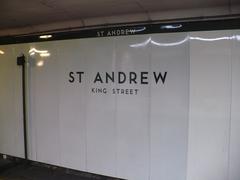
St. Andrew Toronto: Visiting Hours, Tickets, and Historical Sites Guide
Date: 15/06/2025
Introduction to St. Andrew’s Church Toronto
St. Andrew’s Church, located in downtown Toronto, is a remarkable landmark that embodies the city’s rich historical, architectural, and cultural heritage. Established in 1830 as one of Canada’s oldest Presbyterian congregations, St. Andrew’s has witnessed Toronto’s transformation from a colonial settlement to a thriving metropolis. Its Romanesque Revival building at 73 Simcoe Street, completed in 1876, is renowned for its robust stonework, rounded arches, Scottish and Masonic motifs, and beautiful stained glass windows, including the notable 48th Highlanders window and a museum dedicated to the regiment’s legacy.
Beyond its architectural grandeur, St. Andrew’s remains a dynamic community hub, recognized for its pioneering role in music, social outreach, and cultural events. Its central location near major attractions such as the Royal Alexandra Theatre, Roy Thomson Hall, Rogers Centre, and the Financial District makes it easily accessible for locals and visitors alike. This guide provides a detailed overview of St. Andrew’s history, cultural significance, visitor information, and surrounding attractions—ensuring you make the most of your visit to one of Toronto’s most iconic historical sites (St. Andrew’s Church website, St. Andrew’s Society of Toronto, Toronto History Timeline).
Contents
- Early Foundations and Origins
- Relocation and Architectural Significance
- Social and Cultural Impact
- 20th Century Challenges and Resilience
- St. Andrew’s in the Urban Context
- Visitor Information: Hours, Tickets, and Accessibility
- Nearby Attractions and Travel Tips
- Historical Events and Community Initiatives
- St. Andrew’s and Toronto’s Diversity
- Heritage Preservation and Visitor Experience
- FAQ
- Conclusion and Call to Action
Early Foundations and Origins
Founded in 1830, St. Andrew’s Church is one of Canada’s oldest Presbyterian congregations. Its first building stood at Church and Adelaide Streets, marking the nascent city’s development as Toronto transitioned from the Town of York to an incorporated city in 1834. Rapid urban growth and a burgeoning population soon made the original structure inadequate, prompting the need for a larger, more prominent place of worship (History of St. Andrew’s; Toronto History Timeline).
Relocation and Architectural Significance
By the mid-19th century, St. Andrew’s congregation relocated to its current site at 73 Simcoe Street. The new church, completed in 1876, is a masterwork of Romanesque Revival architecture, designed by William George Storm. The building features Georgetown sandstone, Queenston stone trim, and Scottish-inspired decorative elements, including Masonic symbols and crow-stepped gables. Its prominent tower, wheel window, and intricate carvings make it a landmark in the city’s skyline (Heritage Trust Ontario; Toronto Journey 416).
Social and Cultural Impact
St. Andrew’s has long been a center of progressive worship and cultural enrichment. It was the first Presbyterian church in Canada to introduce organ music in 1852, reflecting its forward-thinking approach. The church’s relationship with the 48th Highlanders regiment is memorialized in a unique stained glass window and an on-site museum housing historical artifacts, including a Vimy Ridge cross (St. Andrew’s History).
The church also played a vital role in social outreach, founding St. Andrew’s Institute in 1890 as an early center for urban social work. Today, it continues to support diverse community initiatives and hosts concerts, lectures, and cultural gatherings.
20th Century Challenges and Resilience
As Toronto’s downtown shifted from residential to commercial use during the 20th century, St. Andrew’s faced declining local membership and debated relocating. Ultimately, the congregation chose to remain at King and Simcoe, reaffirming its commitment to serving the evolving downtown population. The resurgence of urban living in the 1970s brought new vitality, allowing the church to expand its outreach and adapt to the city’s changing demographics (St. Andrew’s History).
St. Andrew’s in the Urban Context
The church’s location places it at the intersection of heritage and modernity. Surrounded by Toronto’s Financial and Entertainment Districts, St. Andrew’s is steps away from cultural landmarks like the Royal Alexandra Theatre, Roy Thomson Hall, and the Rogers Centre. This central position underscores its enduring relevance as both a historical monument and an active community institution (Toronto History Timeline).
Visitor Information: Hours, Tickets, and Accessibility
Address: 73 Simcoe Street, Toronto, ON
Phone: 416-593-5600
Website: St. Andrew’s Church
- Visiting Hours: Monday to Friday, 9:00 AM–5:00 PM; Saturday, 10:00 AM–4:00 PM; closed Sundays except for worship services.
- Admission: Free for general visits and self-guided tours. Donations welcome; some special events and guided tours may require tickets (St. Andrew’s Visitor Info).
- Accessibility: Fully wheelchair accessible, with ramps, accessible washrooms, and hearing assistance devices available. Contact ahead for special requirements.
- Guided Tours: Offered weekends and by appointment on weekdays. Virtual tours and digital resources are available online.
- Public Transit: Directly opposite St. Andrew subway station (Line 1), with streetcar and bus connections; nearby paid parking is limited.
Nearby Attractions and Travel Tips
St. Andrew’s central location allows easy exploration of Toronto’s top sites:
- Roy Thomson Hall: Premier concert venue, home to the Toronto Symphony Orchestra.
- Royal Alexandra Theatre: Historic Edwardian Baroque theater.
- Rogers Centre & CN Tower: Iconic entertainment and sightseeing spots.
- PATH Underground Network: Extensive indoor shopping and services, directly connected to St. Andrew Station.
- King Street West Dining: Diverse range of restaurants, ideal for pre-theater meals.
- David Pecaut Square, The Bentway: Urban parks with seasonal events.
Travel Tips:
- Use public transit to avoid parking hassles.
- Visit on weekday mornings for a quieter experience.
- Comfortable walking shoes are recommended.
- Check event schedules ahead, especially during festival season.
Historical Events and Community Initiatives
- Introduction of Organ Music (1852): First among Canadian Presbyterian churches (St. Andrew’s History).
- 48th Highlanders Memorials: Stained glass window (1937) and museum with regimental artifacts.
- Social Outreach: Longstanding support for marginalized communities.
- Cultural Events: St. Andrew’s Charity Ball, music festivals, lectures, and traditional Scottish celebrations (St. Andrew’s Society History).
St. Andrew’s and Toronto’s Diversity
Toronto’s multiculturalism is reflected in St. Andrew’s inclusive congregation and outreach activities. The church’s heritage and mission align with the city’s emphasis on diversity and community engagement (Culture in Toronto 2025-2035). Ministries and cultural events welcome people from all backgrounds, strengthening the church’s role as a living hub of tradition and social connection.
Heritage Preservation and Visitor Experience
Ongoing conservation efforts ensure that St. Andrew’s continues to showcase its Romanesque Revival architecture and rich artistic heritage. Visitors can admire the stained glass windows, learn about Scottish symbolism and Masonic motifs, and visit the 48th Highlanders museum. Self-directed and guided tours, as well as virtual experiences, make the site accessible to all (Toronto Journey 416; Heritage Trust Ontario).
Frequently Asked Questions (FAQ)
Q: What are the visiting hours for St. Andrew’s Church?
A: Monday to Friday, 9:00 AM–5:00 PM; Saturday, 10:00 AM–4:00 PM; closed Sundays except for services.
Q: Is there an admission fee?
A: General visits are free; donations are appreciated. Some special events and guided tours may require tickets.
Q: Is the church wheelchair accessible?
A: Yes, with ramps, accessible washrooms, and hearing assistance available.
Q: Can I take photographs inside the church?
A: Photography is permitted except during services. Please be respectful.
Q: Are tours available?
A: Yes, guided tours can be arranged in advance, and self-guided brochures are provided.
Q: How do I reach St. Andrew’s by public transport?
A: The church is directly opposite St. Andrew subway station (Line 1) and is served by multiple TTC routes.
Conclusion and Call to Action
St. Andrew’s Church is a cornerstone of Toronto’s history, culture, and community. Its blend of architectural splendor, Scottish heritage, and ongoing social impact make it a must-visit destination for anyone exploring the city’s past and present. Whether you are drawn by its Romanesque Revival beauty, its role in music and social outreach, or its central position among Toronto’s urban landmarks, St. Andrew’s offers an enriching experience for all.
Plan your visit today:
- Confirm current hours and event details on the official website.
- Download the Audiala app for interactive audio tours and insider tips.
- Follow St. Andrew’s Church on social media for updates on events and community news.
To further deepen your exploration, check out related guides on Toronto’s historical sites, Scottish heritage, and cultural events (Toronto Journey 416, Heritage Trust Ontario).
Experience the intersection of history, architecture, and community at St. Andrew’s Church—a vibrant testament to Toronto’s diverse legacy.
References and External Links
- St. Andrew Toronto: A Historic Landmark and Visitor Guide to One of Toronto’s Most Iconic Historical Sites, 2025, St. Andrew’s Toronto (https://standrewstoronto.org/about-us/history-of-st-andrew/)
- Visiting St. Andrew’s Church Toronto: Hours, Tickets, and Scottish Heritage, 2025, St. Andrew’s Society of Toronto (https://standrewstoronto.ca/history/)
- Toronto History Timeline, 2025, History of Toronto (https://historyoftoronto.ca/blog/the-rich-and-diverse-history-of-toronto-a-timeline-of-events-and-milestones)
- St. Andrew’s Church Location and Architectural Details, 2025, Heritage Trust Ontario (https://www.heritagetrust.on.ca/plaques/st-andrews-church447)
- St. Andrew’s Visitor Info, 2025, St. Andrew’s Toronto (https://standrewstoronto.org/about-us/history-of-st-andrew/)
- Toronto Journey 416: St. Andrew’s Church, 2025, Toronto Journey 416 (https://www.torontojourney416.com/st-andrews-church/)





























































































































































































